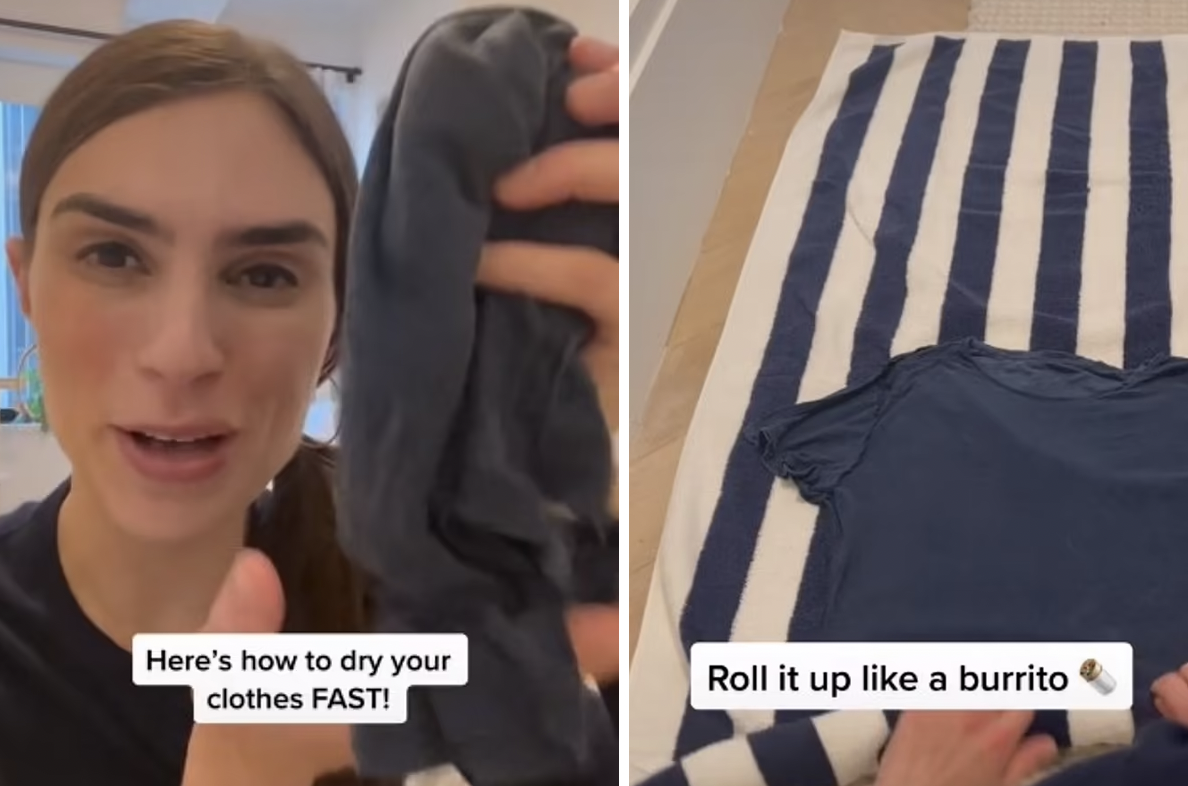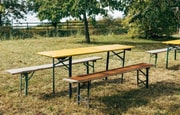Quick tips and tricks to dry your clothes WITHOUT a dryer – especially during the winter
- Replies 23
It's not enough for any of us to just have clean clothes – of course, they have to be dry too! Nobody wants to wear a damp shirt or risk the onset of mould growth.
However, if you live in an apartment, you might only have room for one washer or dryer because of the space constraints. Plus, dryers drain a lot of energy!
While there's always the option of renting an in-unit dryer or going to a laundry facility, these additional costs can add up over time.
There are numerous ways to dry your clothes, regardless of whether you don't have space for a dryer at home, want to save money at the laundromat, or want to be a little more environmentally friendly.

She uses the "burrito" method to squeeze extra water out of wet clothes. Credit: TikTok/@neat.caroline.
Here, a mum demonstrates a clever tip she picked up for quickly blotting up excess moisture with a towel.
Caroline said she starts by lying a towel (the bigger, the better) down on the floor and placing her wet item of clothing on it, starting at the base.
"We're going to do the burrito method," she said. "Grab the base, and just roll it up. Then you're going to press down on the towel with your knees to really wring out the moisture."
After using this method to "wring" out some of the excess water, you can hang the garment on a drying rack in your living room. Now, it won't take the clothes all night to dry, according to Caroline.
You can also use your hairdryer to remove the excess moisture from your clothes, which is another nifty option for drying them if you don't have a dryer in your home. We're pretty sure most of us have hair dryers hiding somewhere, right?
Just lay the item flat, and get the dryer going on the highest setting. The amount of time needed for the clothing to completely dry will depend on the material, but usually, it only takes a few minutes.
"It's a great method to try if you're travelling and have hand-washed something, if you don't have a dryer at home, or if your dryer is broken," added Caroline.
Now that we are well into the colder months of the year, here are some more tips and suggestions for drying your clothes indoors:
Place clothes near a window.
You can air-dry your clothes inside your house if you live somewhere where the winters can get extremely chilly.
Always use the sunniest area of the room with the most windows when hanging wet clothes inside. This will allow for the most airflow and maximise the amount of sunlight that the clothing receives.
Don't hang your clothes to dry in the basement.
The basement is never a good place to hang your clothes. This is because basements have less natural light and airflow. Additionally, the extra moisture on your clothing can make some of the issues with humidity and poor air quality worse.
If you live in a place with high humidity even in the winter, buying a dehumidifier will help your clothes dry faster and improve the quality of the air inside your home.
Use a retractable indoor clothesline.
Most people are reluctant to place a stationary clothes hanger in the centre of their living room during the winter because it eats a lot of the available space.
With the ability to be retracted and stored when not in use, retractable clotheslines offer a lot of space for drying clothes, allowing them to dry quicker.
Use radiators and other indoor heating sources.
When drying clothes inside, homes with radiators or boilers can use the source of heat and air to dry clothes quicker.
Portable radiator drying racks can be put right on top of the radiator without blocking the airflow, so you can still use the heat it gives off.
There you have it, folks! While a traditional dryer makes drying clothes easier, it also consumes a lot of energy and is quite expensive.
These tips for drying clothes in the winter are an easy way to make your home more eco-friendly and cost-effective. Do you have other suggestions you want to share? Let us know in the comments, your fellow members might find it useful this winter!
For more tips on hang drying your clothes, check out the video below:
Credit: miss methodical.
However, if you live in an apartment, you might only have room for one washer or dryer because of the space constraints. Plus, dryers drain a lot of energy!
While there's always the option of renting an in-unit dryer or going to a laundry facility, these additional costs can add up over time.
There are numerous ways to dry your clothes, regardless of whether you don't have space for a dryer at home, want to save money at the laundromat, or want to be a little more environmentally friendly.
She uses the "burrito" method to squeeze extra water out of wet clothes. Credit: TikTok/@neat.caroline.
Here, a mum demonstrates a clever tip she picked up for quickly blotting up excess moisture with a towel.
Caroline said she starts by lying a towel (the bigger, the better) down on the floor and placing her wet item of clothing on it, starting at the base.
"We're going to do the burrito method," she said. "Grab the base, and just roll it up. Then you're going to press down on the towel with your knees to really wring out the moisture."
After using this method to "wring" out some of the excess water, you can hang the garment on a drying rack in your living room. Now, it won't take the clothes all night to dry, according to Caroline.
You can also use your hairdryer to remove the excess moisture from your clothes, which is another nifty option for drying them if you don't have a dryer in your home. We're pretty sure most of us have hair dryers hiding somewhere, right?
Just lay the item flat, and get the dryer going on the highest setting. The amount of time needed for the clothing to completely dry will depend on the material, but usually, it only takes a few minutes.
"It's a great method to try if you're travelling and have hand-washed something, if you don't have a dryer at home, or if your dryer is broken," added Caroline.
Now that we are well into the colder months of the year, here are some more tips and suggestions for drying your clothes indoors:
Place clothes near a window.
You can air-dry your clothes inside your house if you live somewhere where the winters can get extremely chilly.
Always use the sunniest area of the room with the most windows when hanging wet clothes inside. This will allow for the most airflow and maximise the amount of sunlight that the clothing receives.
Don't hang your clothes to dry in the basement.
The basement is never a good place to hang your clothes. This is because basements have less natural light and airflow. Additionally, the extra moisture on your clothing can make some of the issues with humidity and poor air quality worse.
If you live in a place with high humidity even in the winter, buying a dehumidifier will help your clothes dry faster and improve the quality of the air inside your home.
Use a retractable indoor clothesline.
Most people are reluctant to place a stationary clothes hanger in the centre of their living room during the winter because it eats a lot of the available space.
With the ability to be retracted and stored when not in use, retractable clotheslines offer a lot of space for drying clothes, allowing them to dry quicker.
Use radiators and other indoor heating sources.
When drying clothes inside, homes with radiators or boilers can use the source of heat and air to dry clothes quicker.
Portable radiator drying racks can be put right on top of the radiator without blocking the airflow, so you can still use the heat it gives off.
There you have it, folks! While a traditional dryer makes drying clothes easier, it also consumes a lot of energy and is quite expensive.
These tips for drying clothes in the winter are an easy way to make your home more eco-friendly and cost-effective. Do you have other suggestions you want to share? Let us know in the comments, your fellow members might find it useful this winter!
For more tips on hang drying your clothes, check out the video below:
Credit: miss methodical.







